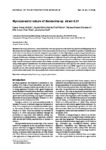Use este identificador para citar ou linkar para este item:
http://www.alice.cnptia.embrapa.br/alice/handle/doc/1030877Registro completo de metadados
| Campo DC | Valor | Idioma |
|---|---|---|
| dc.contributor.author | MELO, I. S. de | pt_BR |
| dc.contributor.author | VALENTE, A. M. M. P. | pt_BR |
| dc.contributor.author | KAVAMURA, V. N. | pt_BR |
| dc.contributor.author | VILELA, E. S. D. | pt_BR |
| dc.contributor.author | FAULL, J. L. | pt_BR |
| dc.date.accessioned | 2015-12-07T11:11:11Z | pt_BR |
| dc.date.available | 2015-12-07T11:11:11Z | pt_BR |
| dc.date.created | 2015-12-07 | pt_BR |
| dc.date.issued | 2014 | pt_BR |
| dc.identifier.citation | Journal of Plant Protection Research, Varsóvia, v. 54, n. 4, p. 327-333, 2014. | pt_BR |
| dc.identifier.uri | http://www.alice.cnptia.embrapa.br/alice/handle/doc/1030877 | pt_BR |
| dc.description | Abstract: In this study, a Bionectria sp. strain isolated from citrus rhizosphere was evaluated for its potential in inhibiting the growth of Rhizoctonia solani and Pythium aphanidermatum. It was demonstrated that Bionectria sp. 6.21 inhibited the growth of P. aphanidermatum and R. solani. In dual cultures, however, the antagonist only parasitised R. solani. Regarding the assay involving P. aphanidermatum, a lack of mycoparasitic ability was demonstrated. Crude extract of Bionectria completely inhibited the mycelial growth of both fungi. It appears that the main mechanism involved in the antagonism of Pythium by Bionectria is through antibiotic production. The antagonistic fungus released extracellular secondary metabolites. The metabolites were found to be inhibitory to both plant pathogenic fungi. From the crude extract, eleven fractions were obtained and tested for their antifungal properties. Two of them showed very strong activity against P. aphanidermatum. The obtained results indicated that this biocontrol agent has both antibiotic and mycoparasitic properties. On the other hand, evidence obtained from Scanning Electron Microscopy (SEM) suggests the involvement of an enzymatic process, with enzymatic digestion playing a major role in the parasitism of Bionectria sp. 6.21. In conclusion, these results provide evidence that mainly due to mycoparasitism, this strain has the potential to become a good candidate for biological control. | pt_BR |
| dc.language.iso | eng | eng |
| dc.rights | openAccess | eng |
| dc.subject | Atividade antifúngica | pt_BR |
| dc.subject | Antifungal activity | pt_BR |
| dc.subject | Bionectria sp | pt_BR |
| dc.subject | Plant diseases | pt_BR |
| dc.subject | Mycoparasits | pt_BR |
| dc.title | Mycoparasitic nature of Bionectria sp. strain 6.21. | pt_BR |
| dc.type | Artigo de periódico | pt_BR |
| dc.date.updated | 2016-01-25T11:11:11Z | pt_BR |
| dc.subject.thesagro | Fungo | pt_BR |
| dc.subject.thesagro | Fungo para controle biológico | pt_BR |
| dc.subject.thesagro | Controle biológico | pt_BR |
| dc.subject.thesagro | Rhizoctonia solani | pt_BR |
| dc.subject.thesagro | Pythium aphanidermatum | pt_BR |
| dc.subject.thesagro | Doença de planta | pt_BR |
| dc.subject.nalthesaurus | Fungi | pt_BR |
| dc.subject.nalthesaurus | Plant diseases and disorders | pt_BR |
| dc.subject.nalthesaurus | Biological control agents | pt_BR |
| dc.subject.nalthesaurus | Antifungal properties | pt_BR |
| dc.subject.nalthesaurus | enzymes | pt_BR |
| riaa.ainfo.id | 1030877 | pt_BR |
| riaa.ainfo.lastupdate | 2016-01-25 | pt_BR |
| dc.contributor.institution | ITAMAR SOARES DE MELO, CNPMA; ANGELA MARIA MONTES PERAL VALENTE; VANESSA NESSNER KAVAMURA, FAPESP; ELKE SIMONI DIAS VILELA, CNPMA; JANE LOUISE FAULL, University of London. | pt_BR |
| Aparece nas coleções: | Artigo em periódico indexado (CNPMA)  | |
Arquivos associados a este item:
| Arquivo | Descrição | Tamanho | Formato | |
|---|---|---|---|---|
| 2015AP07.pdf | 5,66 MB | Adobe PDF |  Visualizar/Abrir |









